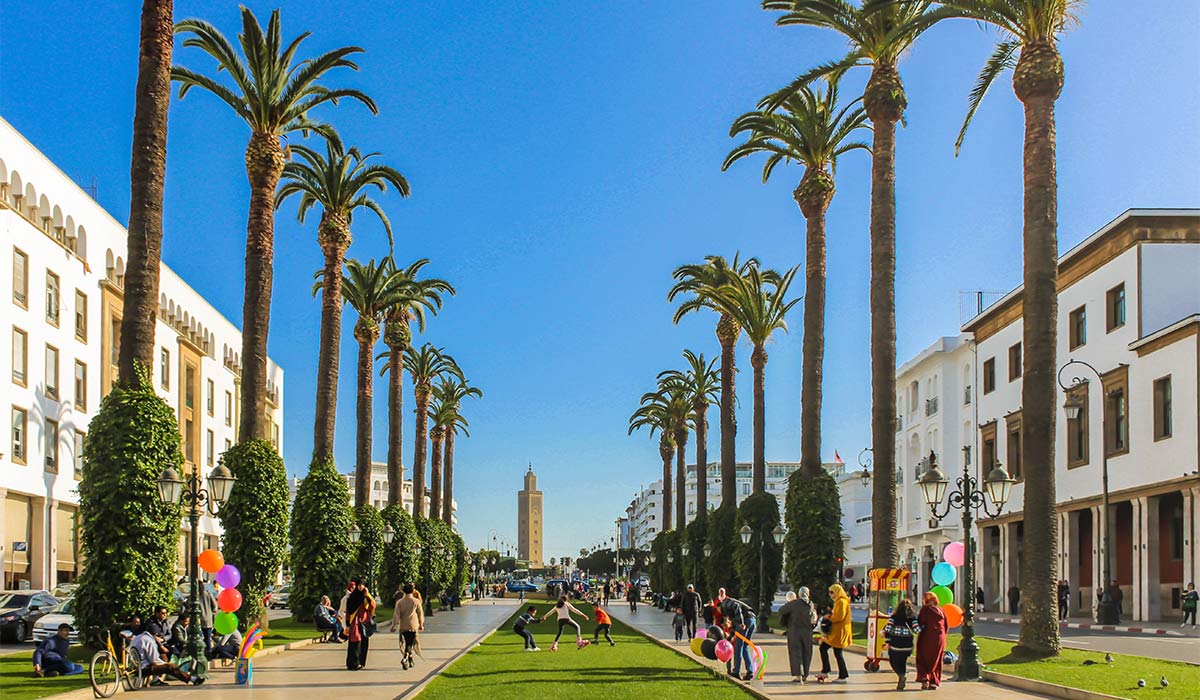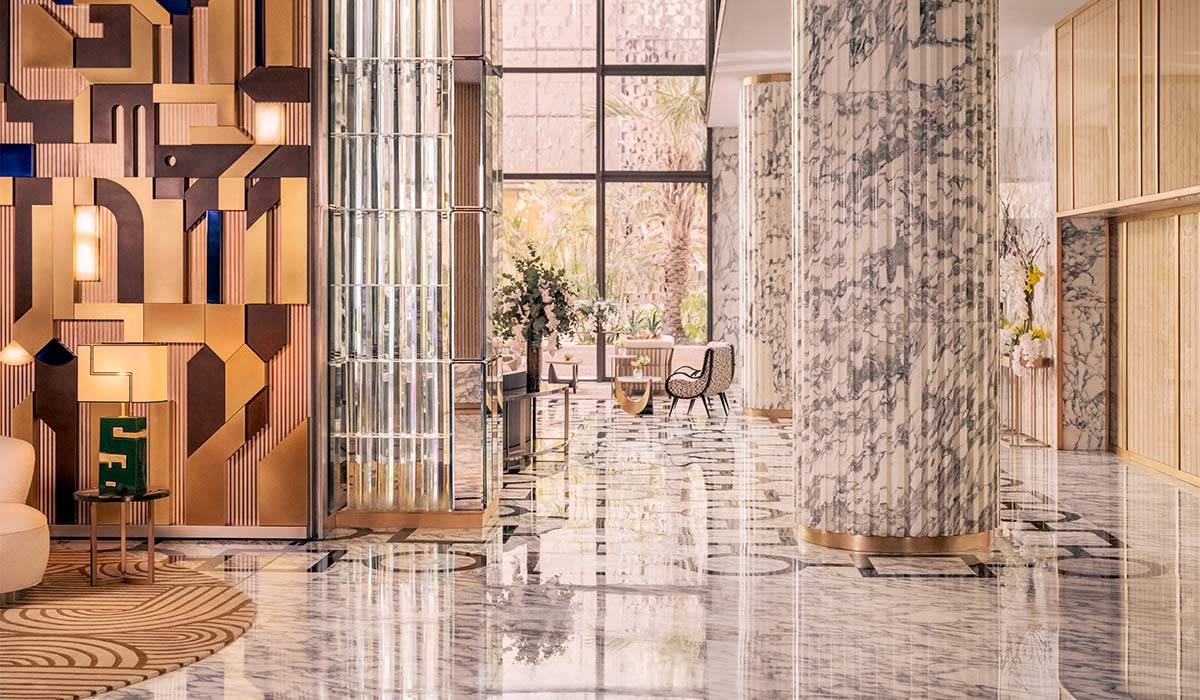In an increasingly over-touristed world with many destinations falling victim to their own success, it's often the second-tier cities, the ones that wouldn't have caught a second glance, that are sitting up in their lonely corners suddenly looking sexy.
With year-round sunshine, Morocco's perennial appeal isn't hard to fathom. Located as far south as the Canaries, for the sunstarved traveller it proffers the same instant cold relief, but all wrapped up in a mesmerising panoply of endless cultural diversions. The bustling souks of Marrakech and the sun-soaked beaches of Agadir aren't likely to lose their magnetic attraction any time soon, but you're definitely not going to be alone there.
In March, Ryanair unveiled a new direct route from Dublin to the Moroccan capital, Rabat, opening up an opportunity to experience a less frenzied, yet every bit as captivating corner of the country.

Seamlessly connected to each other by a new highspeed train, Rabat and the country's largest conurbation, Casablanca - two cities largely shunned by mass tourism - are quietly attracting attention.
They've also recently debuted a couple of stunning luxury hotels, that for those with any inclination towards a little self-indulgence, represent attractive bang for your buck.
Rabat, like Casablanca 90km further down the coast, occupies a picturesque setting looking out across the Atlantic.

Its characterful Unescolisted 17th century medina is a much more tranquil, user-friendly affair than those of Marrakech and Fez. Gazing down from the 12th century Kasbah des Oudayas, a one-time pirate fortress, across the Bou Regreg Rver to Rabat's sister city of Salé, the views are spectacular.
In Salé, where bartering among the plethora of artisans and market traders delivers an even more rewardingly authentic experience, I encountered not one other foreigner.
With its white downtown five years, 500 acres of parks and greenery, pristine squeaky-clean streetscape and a prominent diplomatic community, Rabat impresses as cultured and civilised.
Cultural tourism is where the city is projecting itself. Since 2001, Rabat has hosted one of the biggest music festivals in the world that you've probably never heard of - the Mawazine Festival. Regularly pulling in more than 2 million attendees across ten days in June, big names like Stevie Wonder and Jennifer Lopez share the limelight with global artists and local African musicians.
There's also a host of world-class museums including the recently opened National Museum of Jewellery in the medina, though it's the striking ultra-modern new Grand Theatre next to the river, visible from all directions, that's the focus of attention.
The final project of the late 'starchitect', Zaha Hadid, just as with the Sydney Opera House when it appeared in 1973, it's currently dominating the conversation as well as the landscape.

Full of Hadid's trademark flowing curves, representing the swirling ebb and flow of the Bou Regreg River, it's a stunning example of contemporary architecture. At least from the outside.
Very few people have seen inside the 1,800-seat auditorium, as, while it was completed in 2021, Africa's largest theatre - recently renamed the Royal Theatre - has yet to open. A new footbridge over the river is also planned to enable easy access to Salé.
With a flight time from Dublin of just three-and-a half hours, a culturally infused few days anchored around the new theatre will undoubtedly exert a lot of interest, as it will right across Europe.

Together with the 2030 World Cup, which Morocco co-hosts with Spain and Portugal, where matches are scheduled for Rabat, it's no surprise that hotel groups are eyeing the capital.
In late 2024, Four Seasons debuted Rabat at Kasr Al Bahr (Palace by the Sea), just a 15-minute seasprayed stroll along Rabat's corniche from the medina.
On the former site of an 18th-century sultan's palace, and latterly an early 20th-century French military hospital, it's an expansive and stylishly conceived melding of contemporary cutting-edge chic and elegant traditional Moroccan design, encompassing six heritage buildings and five newly-constructed ones. Film aficionados might recognise it as a location from 2015's American Sniper.

With several toptier dining options, the standout being the Italian, Verdello, balconies from which to watch the sun setting over the ocean and a notably welcoming approach to families, perhaps the most impressive feature of this sprawling luxuriouslyappointed property is its huge, unapologetically opulent spa complex.
The perfect final stop perhaps after a day spent out on the culture trail.
Al Boraq - 'the lightning' in Islamic tradition - is the name of the winged supernatural creature upon which the prophet Muhammed rode for his fabled night journey from Mecca to Jerusalem. It's also the name given to Morocco's new double-decker high-speed train, inaugurated in 2018, running from the country's northern tip at Tangier, down to Rabat and Casablanca.

The seriously high-speed section of the line currently operates only between Tangier and Kinetra, just north of Rabat, where the sudden jolt into action really does feel like a crack of lightning.
My fabulously wild ride into Tangier notched up an effortless 320kmph.
Journey times are slashed, with Tangier to Rabat taking 1 hour 30 minutes, and Tangier to Casablanca 2 hours 10 minutes, from its previous 4 hours 45 minutes. The new line from Kinetra to Marrakech is planned to open in time for the World Cup, when those journey times will be slashed even further.

This bolt of lightning shooting down Morocco's Atlantic coast opens up a plethora of possibilities for travellers to the region, with Tangier, Rabat and Casablanca now suddenly easily accessible to each other. Al Boraq trains are also very reasonably priced, with the small supplement required to travel in the big plush red seats of first class particularly good value.
Just a few minutes from the Four Seasons is the modernised Rabat-Agdal station, from where Al Boraq can whisk you straight to Casablanca in 45 minutes, or just 35 minutes once the new line is completed.
Casablanca is where everyone expects to find Humphrey Bogart slumped over a bourbon in Rick's Café.

Despite the iconic film being shot almost entirely in a Hollywood studio, there actually is a Rick's Café, created in 2004 by former American diplomat Kathy Kriger, which is, in fact, surprisingly well conceived. That's about the beginning and the end, though, of any connection between the film and the real-life city.
Casablanca, with a population of 4 million, is Morocco's Manhattan, its 21st century forwardfacing sprawling metropolis and commercial centre, where the wide-eyed come to make their fortunes. Casablanca isn't interested in serving up tourists with a camel-riding, fez-wearing, snake-charming pastiche, specifically for their entertainment, it's far too busy trying to make money. That may be why visitors often survey the city with a shrug of indifference, though the rough and tumble can conceal a cornucopia of undiscovered delights for those willing to go digging for them.

In 2010, the King of Morocco, Mohamed VI, decided to release his inner hotelier, with the opening of the Royal Mansour Marrakech, a jaw-droppingly sumptuous property of 53 riads, traditional houses arranged around an inner courtyard.
As a multibillionaire, his motivation was probably correlated to showcasing traditional Moroccan craftsmanship as much as with any profit motive.
Last year, a second Royal Mansour opened in Casablanca, this time in a 1950s high-rise, and while no less stunning, it's pegged at a much more approachable price point.

The 24-floor building has been subjected to a meticulous eight-year renovation, with no expense spared. The king doesn't do things by halves and a quite unique aura of opulence sets the property apart from the merely luxurious.
With 30,000sqm of 70 different types of beautifully worked marble, it dazzles from the first steps across the threshold. On the fourth and fifth floors is the palatial spa area, Casablanca's largest, and on the ground floor, a French restaurant overseen by three-Michelinstarred Éric Fréchon, presenting what is undoubtedly the finest French cuisine in the city.
It is, perhaps, to the 23rd floor, though, where the hungry and the thirsty might need to be heading.

Accessed by a vertigoinducing glass footbridge and affording stunning views out across the Atlantic, the Rooftop Bar is as seductive a watering hole as can be encountered in north Africa, located right next door to the spectacular La Grande Table Marocaine restaurant.
Watching the sun splaying the last of its multi-coloured munificence on to a shimmering sea and across the medina's raggedy rooftops, while enjoying the most delectable Moroccan cuisine you're likely to ever encounter, might be another day at the office for King Mohammed, but it's a unique gastronomic experience well worth seeking out for the rest of us.
In Morocco's seemingly impenetrable metropolis, a good guide is a good idea, and city guides don't come much better than Casa native Naima Boussaid, who works with the Royal Mansour. Passionate and extremely knowledgeable, she launches us straight into the labyrinthine streetscape to begin deciphering its secrets, many of which seem to lie buried within Casablanca's architecture.

The French colonists, who in 1912 established a protectorate that prevailed until Morocco eventually unprotected itself in 1956, laid out an ambitiously grandiose art-deco city which, during the inter-war years, emerged as a sun-strafed exotic escape for Francophone socialites.
Naima knows where all the architectural jewels are hidden, from the 1930 Eglise du Sacré Coeur with its twin towers made to look like minarets, in a crass or clever, depending on your view, attempt to forge some symmetry between coloniser and colonised, to the City Hall, the Palais de Justice and the fabulous 1929 Cinéma Rialto, which still regularly shows the city's namesake movie.

The one omnipresent building, visible from pretty much everywhere, is the Hassan II Mosque, completed in 1993 after 1,400 artisans toiled away in the daytime, and another 1,100 at night, for seven years.
Constructed out over the sea, with a retractable roof and a minaret that at 210m was the highest in the world until neighbouring Algeria built an even bigger one in 2019, it accommodates up to 105,000 worshippers both inside the prayer hall and across the expansive outdoor areas.
It's one of only two mosques in the country facilitating entry for non-Muslims and is a must-see.

Running away along the coast from the mosque, the 3km-long corniche of this determinedly contemporary city looks at times as if north Africa wants to become southern California, with its oceanside sequence of surf clubs, outdoor gyms and restaurants.
It was, though, probably the old medina, just a 10-minute stroll from the Royal Mansour, that I found most compelling. Enclosed within a high wall, as if it was spoiling the view from the newly-constructed colonial city, inside it's a warren of authentic, atmospheric alleyways and bustling babbling humanity.
Here, normal people buy everyday stuff and go about their business much as they always have done.

If international tourism has been turning its nose up at Casablanca, then the consequences of that would seem to be refreshingly rough and unadulterated experiences there for the taking amid the melee of the medina's foreigner-free streets. Nobody is frantically trying to sell me something I don't need because they're too busy buying and selling things they actually need themselves.
One thing I definitely didn't need was a baby shark, which Ryanair probably wouldn't approve of in my cabin bag anyway, but I did have a very interesting chat with a man who seemed to have quite a lot of them, as he readied them for sale.
Unlike other touristdependent areas of the country, people here are unlikely to bother you yet are still friendly and open when you do engage.
There's talk of redevelopment inside the medina, where some of the neglected ancient buildings have been collapsing in recent years which hopefully isn't going to lead to a degradation of its character.
Either way, for those with any inclination to sidestep Morocco's traditional tourist trail, these two suddenly very accessible cities on the Atlantic coast invite the traveller towards a delightfully different view of this relentlessly fascinating country.
TRAVEL FACTS
Ryanair flies Dublin to Rabat from €29.99 each way, see ryanair.com. Rooms at the Four Seasons Rabat at Kasr Al Bahr from €400 per night, with breakfast from €40 per person, visit fourseasons.
com. Rooms at the Royal Mansour Casablanca from €550 B&B, see royal mansour.com.







